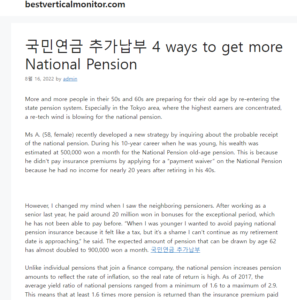More and more people in their 50s and 60s are preparing for their old age by re-entering the state pension system. Especially in the Tokyo area, where the highest earners are concentrated, a re-tech wind is blowing for the national pension.
Ms A. (58, female) recently developed a new strategy by inquiring about the probable receipt of the national pension. During his 10-year career when he was young, his wealth was estimated at 500,000 won a month for the National Pension old-age pension. This is because he didn’t pay insurance premiums by applying for a “payment waiver” on the National Pension because he had no income for nearly 20 years after retiring in his 40s.
However, I changed my mind when I saw the neighboring pensioners. After working as a senior last year, he paid around 20 million won in bonuses for the exceptional period, which he has not been able to pay before. “When I was younger I wanted to avoid paying national pension insurance because it felt like a tax, but it’s a shame I can’t continue as my retirement date is approaching,” he said. The expected amount of pension that can be drawn by age 62 has almost doubled to 900,000 won a month. 국민연금 추가납부
Unlike individual pensions that join a finance company, the national pension increases pension amounts to reflect the rate of inflation, so the real rate of return is high. As of 2017, the average yield ratio of national pensions ranged from a minimum of 1.6 to a maximum of 2.9. This means that at least 1.6 times more pension is returned than the insurance premium paid by the subscriber. Even with the same premium, the following applies: the longer the insurance period, the higher the pension amount. Let’s take a look at four ways to use the state pension system to get “more.” nicetomeetya
1 Period without income → late payment
Deferred payment of the national pension (hereinafter referred to as late payment) refers to those who have not made any payments during the period when they were excluded from participating in the national pension due to reasons such as unemployment, business closure, termination of working life and a housewife etc. Accelerate later payment of insurance premiums.

Looking at the ages of late payment claimants in the last year, 71,234 (51.5%) were in the over 60s, followed by 50,386 (36.4%) in their 50s. On the other hand, those in their 30s (3%) and 40s (8.6%) had significantly lower percentages. It is analyzed that late payments are mainly used by people between 50 and 60 years of age who are about to draw their pension as a means of saving for old age.
By region, applicants are concentrated in metropolitan areas such as Seoul (24.6%), Gyeonggi (24%) and Busan (7.5%), with a relatively high percentage of applications from affluent residential areas such as Seoul’s Gangnam-gu and Songpa-gu . It turned out to be expensive. The number of late payments has increased rapidly from 29,984 in 2013 to 138,424 in 2017. By the end of May this year, 52,568 people have already applied, and the heat is so hot. The late payment surcharge can be paid in full at once or, in the case of large amounts, in installments of up to a maximum of 60 months.
2 visit flat rate → return journey
Ms B. (57), a full-time housewife, worked from January 1988 to March 1990 and received a lump sum reimbursement one year after termination. After that, in February 2015, I got a job in a company where I got married and lived as a full-time housewife. In October 2017, he was able to repay the lump-sum settlement he had previously received and received a monthly pension of 268,000 won at the age of 63. Mr B. then applied for the additional payment and paid out the pension amount.
I added more. Prior to 1999, a lump-sum refund could be requested after a year had elapsed since eligibility ceased. The lump sum can be refunded if the person who received the lump sum in the past is reemployed.
If you become a member of the national pension scheme, you can submit an application. By accruing interest on the capital refund received at that time, the benefit period is restored and the pension amount is increased. Refunds can be temporarily paid out in full or split up to 24 times for large amounts.
3 People with Payment Exceptions/Over 60 → Voluntary Enrollment/Voluntary Continuous Enrollment
Ms. C., a full-time housewife in her forties, had previously paid contributions to the national pension for seven years, but had to pay the national pension due to a career break.